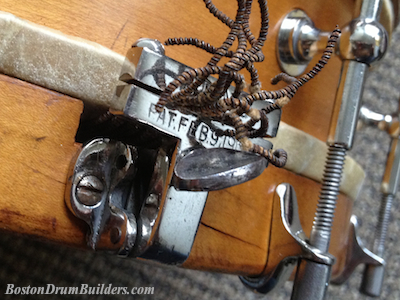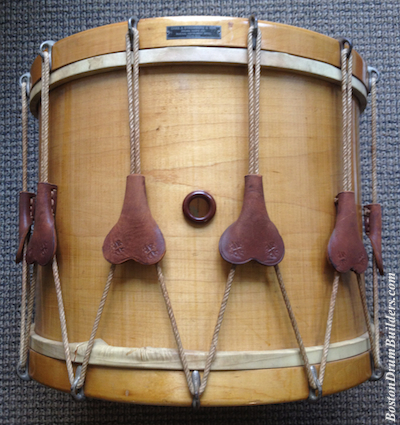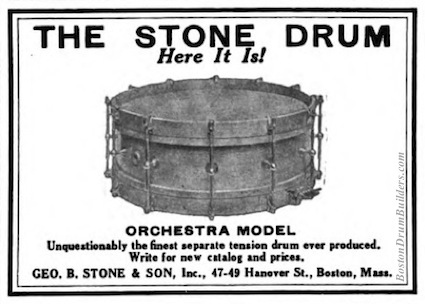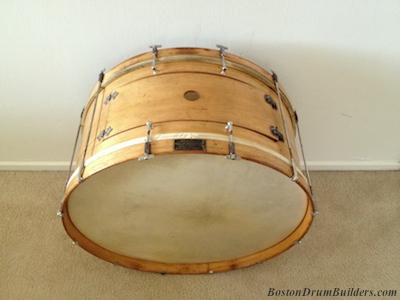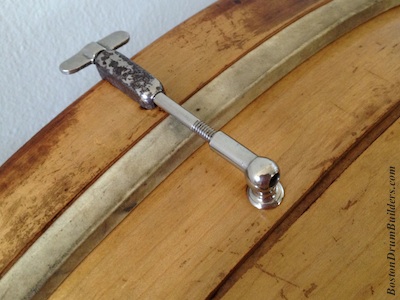During the early 1920s, four of the
Boston Drum Builders were at or near their prime. Over the next two decades, each would disappear from the drum making map for different reasons.
Harry A. Bower was more of an assembler than a manufacturer per se. Many if not all of his instruments are presumed to have been produced largely by third parties such as machine shops or local craftsmen. Bower certainly was active in the designing and patenting of his creations, and was purported to have been quite the promoter of his wares, but he is not known to have ever had a factory full of workers under his command. So when Bower followed the rapidly evolving entertainment business to Southern California around 1925, his drum building efforts seem to have subsided. The last dated Bower drum I am aware of is from December of 1924. Bower did apply for and receive three patents while living in California in the late 1920s and early 1930s, but it is unknown whether any instruments implementing these designs were ever produced, much less marketed and sold.
Nokes & Nicolai's ending was relatively simple and concise. It is well documented in trade publications of the era that Nokes & Nicolai along with local string instrument maker Joseph Pancheco merged with the Liberty Rawhide Company of Chicago in 1926 to form The Liberty Musical Instrument Company. The looming question then is 'Why did Nokes & Nicolai chose to essentially sell their company?' We have no answer for that.
It would appear that Nokes & Nicolai was doing reasonably well at the time producing high quality professional level instruments well into the 1920s. They were financially stable enough just a few years earlier in 1922 to have purchased the F. E. Cole banjo business. And with both of Nokes & Nicolai's namesakes staying on with the new venture in Chicago, it doesn't appear that either man was looking to get out of the industry. Perhaps business has become bad for Nokes & Nicolai in Boston by 1926. Perhaps the two owners felt that the industry was passing them by. Or perhaps they just got an offer too good to refuse. We may never know.
The Liberty Musical Instrument Company was short lived, failing within two years time and was soon acquired by the Slingerland Company, also of Chicago. So in some small way Nokes & Nicolai lived on well into the 20th century, though to be honest, few if any of the instruments built by Slingerland bore any resemblance whatsoever to those being sold by Nokes & Nicolai in Boston only a few years earlier.
George B. Stone & Son was a family operation in name only by the 1920s with the elder Stone, George Burt, having passed away in 1917. But under the younger George Lawrence's oversight the company reached it's peak by the early to mid 1920s both in quantity and quality of instruments being turned out. It appears, however, to have been mostly downhill from there. The late Ralph Eames may have described the circumstances best in an interview with Rick Mattingly for Modern Drummer Magazine in 1985:
| "When mechanization hit the drum industry it sort of passed Mr. Stone by. His business was primarily a handmade operation, and he didn't want to convert to the equipment that would have been necessary for him to compete with companies like Ludwig, Slingerland, and Gretsch. So the business gradually petered out." |
And there you have it in a nutshell. Stone never modernized. Case in point: Stone was producing drums employing wood hoops and an archaic tensioning system for more than a decade after the major players in the industry had moved to metal hoops and standardized tension rods. It was impossible for Stone to keep up like that and eventually they just stopped trying. By the very end, the company was assembling only basic single tension drums with whatever parts were left in the shop making for a sad end to a manufacturing business that once made professional quality, state of the art instruments.
We know that Stone was still building drums, albeit it in dwindling numbers, into the mid 1930s but the factory was closed for good by the late 1930s or early 1940s and the drum making equipment sat dormant for the next decade before it was purchased by Raplh Eames in 1950.
Eames Drum Company of Saugus, Massachusetts, which is still in operation today, is owned and operated by Joe MacSweeney just a few miles north of Boston and represents the closest thing to a direct lineage shared between any modern drum maker and the Boston Drum Builders of the early 20th century.
And last but not least we have
Charles A. Stromberg. It wasn't that Stromberg disappeared so much as that he and his son Elmer simply shifted their focus away from building drums, harps, and banjos to the making of guitars for which they would ultimately become renowned. By the late 1920s, Stromberg's snare drums had evolved into the most modern of any built by a Boston maker of the day. Solid aluminum hoops, elegant separate tension tube lugs, and a fully functional (if slightly over-built) snare throw-off easily separated Stromberg's drums from their local competitors. But as Stromberg was basically a two man operation, their output was very small with the total number of drums produced by the 1930s said to have been only in the 400 range. It would make sense that Stromberg was drawn not only to the more popular instruments of the day for which there was more demand, but where the profit margin was higher for each instrument sold. Though Stromberg's later drums are not numbered or dated, it appears that they were fazed out through the late 1920s and early 1930s as their guitars began increasing in notoriety and popularity. Charles and Elmer Stromberg would continue building guitars until their deaths in 1955.
Do you have a drum built by one of the early 20th century Boston makers? I want to hear from you! Send Lee an email at
lee@vinson.net.






